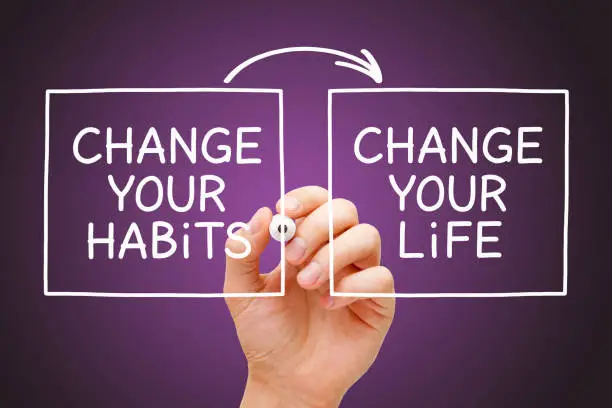🌟 Introduction
You wake up on January 1st ready to conquer the world: new diet, new gym routine, maybe journaling or reading daily. Fast forward to February… and those shiny new habits? Gone.
Sound familiar? You’re not alone. Most people struggle to make habits stick because they focus on willpower and motivation instead of systems and strategy.
In this guide, we’ll explore how to build habits that actually last — even when life gets messy.
🔍 What Is a Habit?
The Science of Habit Formation
A habit is a behavior repeated regularly that becomes automatic over time. From brushing your teeth to scrolling your phone — your brain loves patterns.
Habit Loop: Cue, Routine, Reward
According to Charles Duhigg (author of The Power of Habit), every habit follows this loop:
- Cue – The trigger (e.g., waking up)
- Routine – The behavior (e.g., drinking coffee)
- Reward – The outcome (e.g., feeling awake)
Understand the loop, and you can rewire it.
😩 Why Good Habits Are Hard to Keep
Motivation Isn’t Enough
Motivation is unreliable. Some days you’re fired up. Others? Not so much. That’s why habits need to run on systems, not emotions.
The Comfort Zone of Old Routines
Your brain loves the familiar — even if it’s unhelpful. Breaking old loops takes effort, awareness, and consistent replacement.
✅ Step 1: Start Tiny
The Power of Mini Habits
Want to start working out? Don’t aim for 60 minutes daily. Start with 5 push-ups. Or just putting on your workout clothes.
Small wins build momentum and self-trust.
Avoiding All-Or-Nothing Thinking
“All or nothing” often becomes nothing. Instead of perfection, aim for consistency — even if it’s messy.
🔗 Step 2: Attach New Habits to Existing Ones
Habit Stacking Explained
Attach a new habit to something you already do. For example:
- After I brush my teeth, I’ll meditate for 1 minute.
- After pouring my morning coffee, I’ll journal for 30 seconds.
Examples for Everyday Life
- After dinner → Take a 5-minute walk
- After checking email → Stretch for 1 minute
- Before bed → Write 1 thing you’re grateful for
Stacking makes habits easier to remember and harder to skip.
👀 Step 3: Make It Obvious
Environment Shapes Behavior
If you want to read more, put books where you see them. Want to eat healthier? Put fruit on the counter — not chips.
Visual Cues and Triggers
- Use sticky notes
- Set reminders on your phone
- Lay out your workout clothes the night before
Make good habits visible and accessible.
😍 Step 4: Make It Attractive
Pair Habits with Pleasure
Make habits something you look forward to. How?
- Listen to music while cleaning
- Watch your favorite show only while on the treadmill
- Burn a candle while journaling
Use Temptation Bundling
Link a habit you should do with one you want to do.
- Only listen to your favorite podcast while walking
- Only scroll social media after 5 minutes of reading
🚀 Step 5: Make It Easy
Remove Friction
If a habit is hard to start, you won’t. So:
- Put your gym shoes by the door
- Meal prep healthy snacks
- Set up auto-billing for savings
Use the Two-Minute Rule
Start with just 2 minutes of the habit. Anyone can do that.
- Meditate for 2 minutes
- Journal 1 sentence
- Read 1 page
Once you start, you’ll likely continue.
🎉 Step 6: Make It Satisfying
Celebrate Wins (Even Small Ones)
Reward yourself immediately after the habit. This helps your brain associate the habit with good feelings.
- Say “Yes!” out loud
- Mark an X on a calendar
- Give yourself a sticker (yes, really)
Use Immediate Rewards
Long-term goals are great, but immediate rewards drive behavior. Celebrate progress often.
📅 The Importance of Tracking
Habit Trackers & Journaling
Use a habit tracker to see your progress visually. Apps like:
- Habitica
- Streaks
- Notion or a simple bullet journal
Don’t Break the Chain
Inspired by Jerry Seinfeld: mark an X for each day you do the habit. The goal? Don’t break the streak.
🙈 What to Do When You Miss a Day
Missing One vs Giving Up
You’re human. You’ll slip. The key? Never miss twice. Get back on track the next day.
Get Back on Track Quickly
Treat missed days like speed bumps — not stop signs. Learn from them, then move forward.
⚠️ Avoid These Common Mistakes
Trying Too Much at Once
Don’t overhaul your life overnight. Start with one habit at a time.
Relying on Willpower Alone
Willpower is limited. Use systems, reminders, and environment design instead.
🧩 Building Habits for Different Life Areas
Fitness
- Walk 10 minutes after meals
- Stretch while watching TV
- Do 5 squats every bathroom break
Productivity
- Set a 15-minute focus timer
- Write a to-do list every morning
- Clear your desk before bed
Mental Health
- Journal 1 line daily
- Practice gratitude
- Meditate with an app for 2 minutes
🧠 The Role of Identity in Habit Formation
“I Am” Statements and Self-Image
Don’t say: “I’m trying to read more.”
Say: “I’m a reader.”
Aligning your actions with identity makes habits stick.
Acting in Alignment with Your Future Self
Every habit is a vote for the person you want to become.
Want to be healthier? Vote for that version of you with small actions daily.
✅ Conclusion
Building lasting habits isn’t about being perfect — it’s about being persistent.
Start small. Stack habits. Make them easy, enjoyable, and satisfying. And when you slip up? Don’t quit. Restart. Recommit. Repeat.
You’re not just building habits — you’re building a better version of you. One small step at a time.
❓ FAQs
1. How long does it take to build a habit?
Research suggests it takes about 21 to 66 days, depending on the habit and consistency.
2. What if I keep forgetting my habit?
Use visual cues, alarms, and habit stacking to trigger memory.
3. Can I build multiple habits at once?
You can, but it’s more effective to start with one, master it, then add another.
4. Why do I lose motivation quickly?
Motivation fades. That’s why habits must be easy and automatic, not motivation-based.
5. What’s the best app for tracking habits?
Try Habitica, Streaks, HabitBull, or Notion depending on your style.



